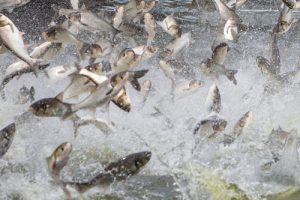In January, 2012, the Great Lakes Commission and the Great Lakes and Saint Lawrence Cities Initiative released a joint study on how to stop the movement of invasive species between the Mississippi and Great Lakes basins.
The study, which presents possible ways in which the Mississippi River and Great Lakes basins can be re-separated, is the first major effort to provide failsafe solutions to preventing the movement of aquatic invasive species between the two watersheds.
Scientific evidence indicates that bighead and silver carps would find portions of the Great Lakes basin to be suitable places to live and reproduce, likely causing ecosystem disruption, and loss of valuable fishery resources. Science behind the Asian carp threat adds pointed urgency for action on the separation study.
The Great Lakes are a valuable resource for both Canada and the United States. The Great Lakes’ commercial, recreational, and tribal fisheries are valued at more than $7 billion annually.
“Asian carps have the ability to spread rapidly, reproduce in large numbers, and become the dominant species in an ecosystem, threatening the significant economic and ecological value these lakes provide,” said Robert Lambe, chair of the Great Lakes Fishery Commission. “Science indicates that, like the sea lamprey and zebra mussel, bighead and silver carps are likely to become permanent components of the Great Lakes if they become established in the system. We simply must not let new species—particularly ones as large and prolific as the silver and bighead carps—into the Great Lakes.”
Dr. Michael Hansen, the commission’s vice-chair, added:
“The science to date, and observing the carp as they migrate throughout the Mississippi River and Illinois River systems, should give scientists, fishery managers, policy makers, and the public more than ample reason to be extremely concerned about these species. Actions, like those proposed by the Great Lakes Commission and the Great Lakes and Saint Lawrence Cities initiative, are particularly urgent given what we know about the bighead and silver carps and their likely impact on the Great Lakes.
“Recent models of food consumption by bighead and silver carps indicate that some areas of the Great Lakes have sufficient food to support populations of these fish. Regions of particular risk include Green Bay and western Lake Erie, but all five Great Lakes will likely provide some habitat for Asian carps. The Great Lakes appear to be suitable environments for bighead and silver carps, particularly in tributary rivers and shallower more-productive areas, where losses of native fish production would be likely be greatest.
“Risk assessments have shown that nearly two dozen tributaries in U.S. waters alone are potentially suitable for Asian carp spawning. Moreover, a recent analysis of U.S. tributaries to Lake Erie, conducted by the U.S. Geological Survey, indicates that the Maumee, Sandusky, and Grand Rivers are most likely to support successful spawning of bighead and silver carps.”
source: Great Lakes Commission
